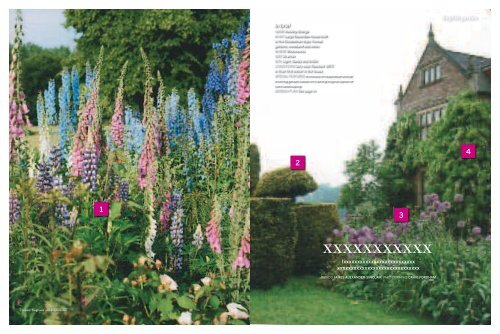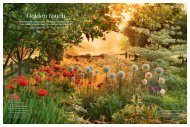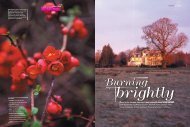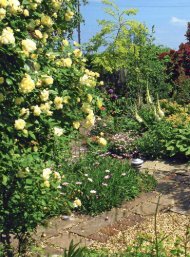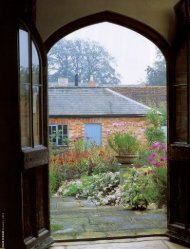xXTyplkxxxxxxxx xxxxxxxxxxxxxxxxxxx xxxxxxxxxxxx ...
xXTyplkxxxxxxxx xxxxxxxxxxxxxxxxxxx xxxxxxxxxxxx ...
xXTyplkxxxxxxxx xxxxxxxxxxxxxxxxxxx xxxxxxxxxxxx ...
Create successful ePaper yourself
Turn your PDF publications into a flip-book with our unique Google optimized e-Paper software.
lupins, foxgloves and delphiniums<br />
1<br />
In brief<br />
NAME Ruckley Grange<br />
WHAT Large Edwardian house built<br />
in the Elizabethan style. Formal<br />
gardens, woodland and water.<br />
WHERE Wxxxxxxxxx<br />
SIZE 10 acres<br />
SOIL Light, Sandy and Acidic<br />
CONDITIONS Very cold. Reached -25°C<br />
in their first winter in the house.<br />
SPECIAL FEATURES A mixture of restoration and an<br />
evolving garden based on a strong original layout of<br />
hard landscaping.<br />
GARDEN PLAN See page xx<br />
2<br />
xxxxxxxxxxx<br />
I<strong><strong>xxxxxxxxxxxx</strong>xxxxxxx</strong>xxxxxxx<br />
<strong><strong>xxxxxxxxxxxx</strong>xxxxxxx</strong>xxxxxxxxxxx<br />
WORDS JAMES ALEXANDER-SINCLAIR PHOTOGRAPHS CRAIG FORDHAM<br />
3<br />
English garden<br />
4<br />
55
56<br />
SOloreet alit augue enit lutpat,<br />
conum dunt atum eu feugiat, ver<br />
iuscips ustrud eugue mod tate<br />
magna con ea augiam irit inci<br />
This place has wonderful bones but<br />
absolutely no garden. These are<br />
not, I hasten to add, my words but<br />
those of renowned nurseryman John<br />
Ravenscroft when he first saw the grounds<br />
at Ruckley Grange 30-odd years ago. He<br />
was being shown round by the proud new<br />
owners, Keith and Margaret Ashbourne, in<br />
the hope that he might have an encouraging<br />
word or two at the beginning of<br />
what has turned out to be a major project.<br />
He was right, of course, and those<br />
bones are still visible today. The house was<br />
rebuilt in an Elizabethan style in 1904 by<br />
the brewing family, the Reid Walkers, the<br />
gardens were laid out at much the same<br />
time but by whom and in what style,<br />
nobody knows. There are only a couple<br />
of surviving photographs and they are<br />
not a great deal of help. What there is,<br />
however, is a magnificent lily pond with<br />
elegant summerhouse, a firm grid of<br />
paths lined up perfectly symmetrically<br />
with the house and a long raised balustrade<br />
separating what must once have<br />
been formal gardens from the surrounding<br />
woodlands and wilder gardens.<br />
Margaret Ashbourne has been involved<br />
with growing things for many years – at<br />
one point she grew 70 acres of flowers for<br />
drying – although now restricts her activities<br />
to the gardens at Ruckley. This fits<br />
around running, with her daughter, a busy<br />
factory on the estate assembling artful<br />
arrangements of artificial flowers. “When<br />
we arrived at Ruckley there was very little<br />
planting except for some rose beds. We<br />
asked David Austin (the renowned<br />
rosarian and near neighbour) to have<br />
“<br />
<strong>xxxxxxxxxxxx</strong>xxx<br />
<strong><strong>xxxxxxxxxxxx</strong>xxxxxxx</strong><br />
<strong>xxxxxxxxxxxx</strong><br />
<strong><strong>xxxxxxxxxxxx</strong>xxxxxxx</strong><br />
<strong><strong>xxxxxxxxxxxx</strong>xxxxxxx</strong><br />
<strong>xxxxxxxxxxxx</strong><br />
“<br />
5<br />
6<br />
a look and he immediately told us to rip<br />
them all out.” This they did, and gradually<br />
the planting around the house has<br />
emerged. It is by no means conventionally<br />
planned and is a combination of two very<br />
different tastes. “Keith likes things to be<br />
very neat and neatly edged: I prefer it a<br />
bit more chaotic.” It seems that Margaret<br />
gets her way much of the time and the<br />
planting gives an air of delightfully<br />
eccentric abundance.<br />
<strong>xxxxxxxxxxxx</strong>x<br />
The main formal view from the house is<br />
from the South Terrace alongside which<br />
magnolias spill out to obstruct paths and<br />
blocks of lavender lap against the stonework.<br />
Facing this are eight L-shaped beds<br />
filled with a mixture of plants, from roses<br />
to great stands of delphiniums and<br />
sprawling geraniums. “There is no strict<br />
colour scheme: I reckon that, as flowers are<br />
multi-coloured, then the borders should<br />
be as well. In spring there are tulips and<br />
erythroniums, and hyacinths as well.”<br />
7<br />
8<br />
SOloreet alit augue enit lutpat,<br />
conum dunt atum eu feugiat, ver<br />
iuscips ustrud eugue mod tate<br />
magna con ea augiam irit inci<br />
10<br />
SOloreet alit augue enit lutpat,<br />
conum dunt atum eu feugiat, ver<br />
iuscips ustrud eugue mod tate<br />
magna con ea augiam irit inci<br />
English garden<br />
9<br />
11
SOloreet alit augue enit lutpat,<br />
conum dunt atum eu feugiat, ver<br />
iuscips ustrud eugue mod tate<br />
magna con ea augiam irit inci<br />
This feeling of quirky abandon runs<br />
through the garden: there are banks of<br />
dahlias against the balustrade, hostas by<br />
the path (oddly there are no slugs in the<br />
garden), lavender everywhere and all the<br />
time the ancient yew topiary and formal<br />
paths look on benevolently. The focal<br />
point for this part of the garden is a spectacular<br />
lead statue of a boy entwined with<br />
a dolphin, which sits in a long stone pond<br />
that was once used for swimming.<br />
<strong>xxxxxxxxxxxx</strong>x<br />
Away from the house there are other<br />
gardens: a grass tennis court has been turned<br />
into a wildflower meadow and there is a fine<br />
walled garden (although the greenhouses<br />
have long since disappeared). This now<br />
houses an eclectic collection of peacocks,<br />
guinea fowl and at least one swan.<br />
Further away, to the west side, across<br />
wide expanses of steeply rolling lawns,<br />
there is a delightful system of streams,<br />
lakes and both formal and informal ponds.<br />
In particular a lovely stone-edged elliptical<br />
58<br />
12<br />
“<br />
<strong>xXTyplkxxxxxxxx</strong><br />
<strong><strong>xxxxxxxxxxxx</strong>xxxxxxx</strong><br />
<strong>xxxxxxxxxxxx</strong><br />
<strong><strong>xxxxxxxxxxxx</strong>xxxxxxx</strong><br />
<strong><strong>xxxxxxxxxxxx</strong>xxxxxxx</strong><br />
<strong>xxxxxxxxxxxx</strong><br />
“<br />
swimming pond fed by a gushing (though<br />
probably darn cold) stone rill.<br />
All of these waterworks have been<br />
restored by the Ashbournes: the complex<br />
system of sluices and drains is Keith’s<br />
department. “We dredged all the lakes and<br />
got rid of many tonnes of mud and sludge<br />
in order to reveal the original shapes.” The<br />
surrounding undergrowth has been cleared<br />
– “in places the bracken used to be growing<br />
over the top of the shrubs” – and the place<br />
is dotted with new shrubs and trees. As this<br />
is good acidic soil there is an abundance<br />
of rhododendrons and thriving magnolias<br />
all along the banks of the lakes. Margaret<br />
13<br />
has planted strong colours so they are<br />
visible from the distant house.<br />
All the best gardens are a labour of love:<br />
a magic connection between people and<br />
places. Rather than following the conventional<br />
route of restoring an historic garden,<br />
Keith and Margaret have embarked on things<br />
purely from instinct and investigation. They<br />
had little choice as there is no masterplan<br />
from which to work, so where a wall ends<br />
abruptly they have guessed where it should<br />
go. Mysteries such as the big mound in the<br />
garden whose purpose was unfathomable<br />
have been solved (in this case by its careful<br />
removal to reveal an unexplainable archway).<br />
This has resulted in not so much a recreation<br />
of a garden as a reinvention based around<br />
the happy combination of the strong bones<br />
that John Ravenscroft noticed, and Margaret<br />
Ashbourne’s joyful determination to plant<br />
whatever she pleases. This is a refreshing<br />
and individual take on garden restoration.<br />
James Alexander-Sinclair is a garden designer<br />
and broadcaster who co-hosted the recent television<br />
coverage of the Chelsea Flower Show 2011.<br />
14<br />
16<br />
foxglove<br />
15<br />
SOloreet alit augue enit lutpat,<br />
conum dunt atum eu feugiat, ver<br />
iuscips ustrud eugue mod tate<br />
magna con ea augiam irit inci<br />
17<br />
English garden
60 61
62 63


